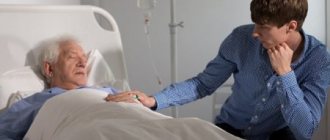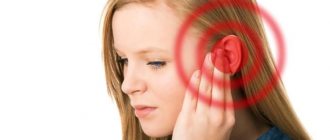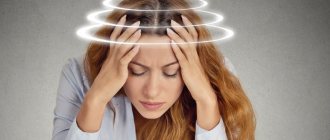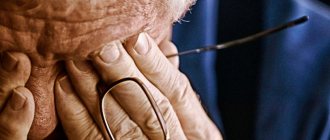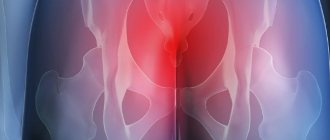If the blockage or spasm of the artery supplying the brain is partial, and movement along a small branch is blocked, then the signs of cerebral ischemia are short-lived. Such small forms of acute disturbance of cerebral blood flow (microstroke) can end on their own. In such cases, the patient is not suspected of a vascular accident and does not undergo treatment.
Over time, persistent damage to neurons occurs with the development of a typical stroke, loss of vision, memory impairment, psyche and mental activity.
Is it possible to have a mini-stroke on your feet?
If neurological symptoms are not persistent and go away without taking medications or with treatment for hypertension or coronary artery disease, then patients (and even specialists) may not be aware of the micro-stroke that has occurred. This situation is associated either with the small size of the brain lesion, or with good blood supply, which compensates for the lack of oxygen and cell nutrition.
The latter is typical for relatively young people without systemic atherosclerosis.
As a rule, at the time of contacting a doctor, there are no signs of the disease, so in-depth diagnosis is not carried out, and the patient does not receive adequate treatment. If the cause that led to the micro-stroke is not eliminated, then circulatory disorders progress and a severe stroke is formed.
Increased alertness regarding a possible vascular accident should arise if there are risk factors:
- cardiac ischemia;
- obliterating atherosclerosis of the lower extremities;
- arterial hypertension (an increase in diastolic pressure to 100 mm Hg increases the risk of stroke by 2.5 times);
- previous heart attack, stroke or cerebral ischemia attack, cerebral hypertensive crisis;
- excess cholesterol, triglycerides in the blood;
- old age (after 65 years the risk is 6 times higher compared to 50 years old);
- rhythm disturbances, especially atrial fibrillation;
- smoking and diabetes mellitus increase the possibility of vascular complications by 3 times;
- obesity, physical inactivity, metabolic syndrome;
- alcoholism and drug addiction;
- use of hormonal drugs, including contraceptives;
- abnormal structure of the vessels of the brain, carotid and vertebral arteries, compression from the outside;
- autoimmune diseases with damage to the arteries;
- migraine;
- cardiomyopathy, rheumatism, bacterial endocarditis, congenital and acquired heart defects;
- venous thrombosis;
- Takayasu, Horton's, Moyamoya disease, periarteritis nodosa;
- antiphospholipid syndrome.
We recommend reading the article about rehabilitation after a stroke at home. From it you will learn about life after a stroke, recovery periods, rehabilitation exercises, and nutritional habits. And here is more information about exercise equipment after a stroke.
Ischemic spinal stroke
Ischemic spinal stroke is an acutely developed circulatory disorder in the spinal cord, which is based on the cessation of blood flow through the vessels feeding it. Characterized by persistent neurological symptoms. In his practice, a neurologist rarely encounters spinal strokes, since they account for only about 1% of the total number of acute circulatory disorders in the central nervous system.
Ischemic spinal stroke can affect patients of a wide range of ages; There are often cases when the pathological process occurs in young people aged 30-35 years. Men and women get sick with approximately the same frequency.
Signs
As with ischemic stroke, clinical manifestations consist of focal symptoms and general cerebral disorders. Therefore, they can be divided into several groups:
- general cerebral – sudden acute headache or gradually increasing, general weakness, nausea, vomiting, brief episodes (sometimes imperceptible) loss of consciousness;
- vegetative – hot flashes, redness of the upper half of the body, sweating, cold hands and feet, muscle tremors;
- carotid (spasm or blockage in the area of the carotid artery) - decreased sensitivity (numbness) or tingling of the skin of the arms and legs, half of the face, weakness in the arm or leg, speech impairment, short-term blindness in one eye, convulsions;
- vertebral arteries - dizziness, noise in the head, unsteadiness when walking, flashes of light in the eyes, disturbance of the outlines of objects, loss of part of the visual field, double vision, loss of clarity of speech, difficulty swallowing, headache and dizziness may increase when turning (tilting) the head ;
- stem part - severe dizziness, impaired eye movements, loss of vision and hearing, loss of balance, swallowing and sensitivity in a limited area of the face, difficulty pronouncing words;
- medulla oblongata – brief loss of the ability to move (“freezing in one position”);
- temporal lobes – loss of orientation in space and time, inability to reproduce current events.
Sometimes there is a combination of two or more groups of characteristics. Such an attack can last from a few minutes to 8 - 10 hours. The next day the patient feels satisfactory, or severe weakness remains.
What if your fingers go numb?
Fingers may go numb separately with the same peripheral neuropathy, depending on which nerves are damaged.
If it is radial, then the thumb and index finger may become numb; if it is ulnar, then the thumb and half of the ring finger, etc.
Meanwhile, compression of the median nerve causes a disease called carpal tunnel syndrome, also known as carpal tunnel syndrome. It also manifests itself as pain and numbness in the fingers and is often found in those who hold their hands in one position for a long time: from gamers to pianists and cyclists.
Consequences for women and men
Recent studies have found that long-term consequences for patients who have suffered a mini-stroke are not as safe as previously thought, even with complete restoration of the neurological status. It is interesting that with conventional diagnostics using CT and MRI, no abnormalities were detected after a month, but when stimulating the cerebral cortex with short magnetic pulses, a disturbance in the processes of neuronal excitation and a longer period of inhibition than normal were detected.
It is assumed that such changes persist for life and are the cause of the appearance in patients who have suffered a transient ischemic attack:
- asthenia – weakness, loss of interest in the environment, weakening of memory;
- neurasthenia – increased irritability, anxiety, insomnia, headache;
- depressive states;
- neurocirculatory dystonia;
- dyscirculatory encephalopathy.
Over the course of 5 years after a microstroke, a third of patients develop acute cerebrovascular accident, leading to a permanent neurological defect (loss of speech, paralysis of the limbs, loss of sensitivity, visual impairment).
Expert opinion
Alena Ariko
Expert in Cardiology
One consequence, less dangerous for the patient, but quite noticeable for others, is a change in personality traits against the background of a malnutrition of the brain. The patient becomes extremely uncooperative, loses most social and family contacts, like hypochondriacs, looks for signs of non-existent diseases, and complains of constant pain that cannot be objectively confirmed. Significant relief of symptoms is observed with neuroprotectors and antidepressants.
Pathogenesis
Cerebral infarction can be caused by airway obstruction, and cerebral hemorrhage can also provoke venous thrombosis if its area is large enough.
In recent years, medical statistics claim that there are many more patients with venous thrombosis. Doctors explain this fact by saying that it is not the incidence rate that has increased, but the number of correctly diagnosed cases.
Only 3-4 people out of a million will have a venous stroke.
What to do if you suspect a microstroke
The first thing that is recommended if you suspect a cerebrovascular accident is to seek emergency medical help. If the attack occurs against the background of high blood pressure, then it must be gradually reduced, but not allowed to fall below 140/90 mm Hg. Art., as this will lead to an even greater deterioration in the nutrition of brain neurons. For this purpose, Dibazol, No-spa, Magnesium sulfate is usually used intravenously or intramuscularly.
Before the ambulance arrives, you must:
- take a horizontal position with your head raised;
- apply cold to the head and a warm heating pad to the feet;
- ensure free flow of fresh air;
- You can take an Aspirin tablet or dissolve 10 tablets of 0.1 g of Glycine.
Then, after eliminating the manifestations of a transient cerebrovascular accident, it is imperative to undergo an examination. It includes:
- consultation with an ophthalmologist, neurologist, cardiologist;
- blood tests - general, coagulogram, lipid spectrum, blood sugar;
- Ultrasound with duplex scanning of the vessels of the head and neck;
- rheoencephalography;
- Brain MRI with angiography;
- X-ray or CT scan of the spine (cervical spine);
- ECG;
- Ultrasound of the heart (as recommended by a cardiologist).
Watch the video about the signs of a microstroke, the reasons for its development and consequences:
Forecast
If the attack of a microstroke did not last long and the blood flow was able to stabilize within a few minutes, then the patient can hope that areas of the brain will not be severely affected, and there will be no significant consequences. But, unfortunately, this does not always happen. In some cases, a microstroke leads to:
- Concentration of attention decreases;
- Memory deteriorates;
- The emotional background is disrupted. Mood swings become more pronounced.
Whether a microstroke will turn into a full-fledged attack depends on many factors: timeliness of first aid, age, health status, and other things.
Treatment and recovery
Patients often undergo treatment on an outpatient basis, since their health remains satisfactory, but given the fact that within a month after the attack it is likely to recur or transform into a stroke, an inpatient course of therapy is considered the most justified.
Medicines can be selected only taking into account diagnostic data, since it is important to eliminate the cause of the micro-stroke. The most common groups of drugs are:
- hypotensive - Prestarium, Arifon;
- antiplatelet agents – Thrombo Ass, Clopidogrel, Curantil;
- anticoagulants (for cardioembolism) – Warfarin, Sinkumar;
- lipid-lowering drugs – Liprimar, Vasilip;
- solutions to improve blood flow - Reopoliglyukin, Glucose, Trisol;
- vasodilators - Cavinton, Sermion, Nimotop, Eufillin;
- neuroprotectors – Semax, Cerebrolysin, Gliatilin, Encephabol.
During the recovery period, patients are prescribed hyperbaric oxygenation, electrophoresis, magnetic therapy on the collar area, radon or pine baths, massage, reflexology, EHF therapy.
If a cholesterol plaque is detected in the carotid artery, which occupies more than 70% of its lumen, surgical treatment is indicated.
Patient position
One of the main points in the treatment of muscle hypertonicity in patients after a stroke is giving the paretic limb a physiological position.
An effective way to combat spasticity
The affected hand should be placed on a chair next to the patient's bed. Due to increased muscle tone, it will be drawn towards the body. To prevent this phenomenon, a soft tissue roller is placed in the armpit.
The arm is extended at the elbow joint and turned palm up. Sandbags or other devices are used to hold the limb in this position. It is advisable to bandage the fingers and hand to a splint.
The duration of positioning treatment is about 2 hours. It can be repeated several times during the day. As soon as the attending physician allows, the patient is helped to sit down and taught to walk.
Physiotherapy
The complex of therapeutic exercises consists of active and passive movements. Passive movements consist of flexion and extension of muscles, which is carried out by caring staff. If possible, the patient makes passive movements using a healthy limb. Due to increased tone, movements may initially be intermittent and abrupt. Over time, the tone decreases and they become smoother.
Exercise is very important for developing muscles and joints
As soon as a patient after a stroke is able to perform active movements, he should engage in therapeutic exercises independently. In addition to flexion and extension exercises, exercises aimed at stretching muscles are added. When performed correctly, they relieve hypertension well and help the patient recover faster.
If the patient has increased muscle tone after a stroke, exercises with expanders, elastic bands, and the like are strictly not recommended - they only intensify spastic phenomena and worsen the situation.
Muscle relaxants
Among the medications used to treat hypertension in patients after a stroke, centrally acting muscle relaxants are used, which effectively relieve muscle tone without affecting their strength. The mechanism of their action is to inhibit pathological impulses that come from spinal motor neurons.
Treatment with muscle relaxants begins with minimal doses. If necessary, they are increased to achieve effect. Expected effects:
- decreased muscle tone;
- improvement of motor functions;
- pain relief;
- prevention of contracture development;
- increasing the effectiveness of therapeutic exercises;
- facilitating patient care.
In our country, the most common muscle relaxants are baclofen, tizanidine, or sirdalud, tolperisone, or mydocalm, diazepam.
Doctors also prescribe muscle relaxants to restore and relax muscles.
The disadvantage of treatment with muscle relaxants is the possibility of developing side effects, the most common of which are:
- drowsiness;
- dizziness;
- nausea;
- constipation;
- decrease in blood pressure.
Massage
Massage relieves increased muscle tone well. It must be carried out from the first days of the disease. From massage techniques, you need to choose stroking and light rubbing. They help reduce muscle tone, improve blood circulation and lymph flow in the paretic limb. The duration of the first sessions should not exceed 10 minutes.
Over time, it is increased to 20 minutes. The duration of the course depends on the individual characteristics of the patient and is determined by the attending physician. As a rule, after 20–30 sessions a break of 10–15 days is required. After this, the course is repeated. The decision to discontinue massage treatment depends on the results achieved.

